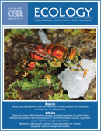Estimating dispersal from genetic isolation by distance in a coral reef fish (Hypoplectrus puella)
Abstract
The spatial scale of dispersal in coral reef fishes eludes ecologists despite the importance of this parameter for understanding the dynamics of ecological and evolutionary processes. Genetic isolation by distance (IBD) has been used to estimate dispersal in coral reef fishes, but its application in marine systems has been limited by insufficient sampling at different spatial scales and a lack of information regarding population density. Here, we present an analysis of IBD in the barred hamlet (Hypoplectrus puella, Serranidae) at spatial scales ranging from 10 to 3200 km complemented with SCUBA surveys of population densities covering 94 000 m2 of reef. We used 10 hypervariable DNA markers to genotype 854 fish from 15 locations, and our results establish that IBD in H. puella emerges at a spatial scale of 175 km and is preserved up to the regional scale (3200 km). Assuming a normal or a Laplace dispersal function, our data are consistent with mean dispersal distances in H. puella that range between 2 and 14 km. Such small mean dispersal distances is a surprising result given the three-week pelagic larval duration of H. puella and the low level of genetic structure at the Caribbean scale (Wright’s fixation index, FST, estimate=0.005). Our data reinforce the importance of considering population density when estimating dispersal from IBD and underscore the relevance of sampling at local scales, even when genetic structure is weak at the regional scale.

